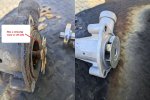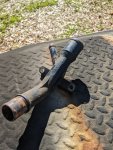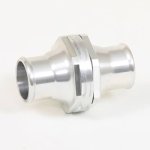-
 Welcome Visitor! Please take a few seconds and Register
for our forum. Even if you don't want to post, you can still 'Like' and react to posts.
Welcome Visitor! Please take a few seconds and Register
for our forum. Even if you don't want to post, you can still 'Like' and react to posts. 
You are using an out of date browser. It may not display this or other websites correctly.
You should upgrade or use an alternative browser.
You should upgrade or use an alternative browser.
2.5L ('98-'01) Well, found out why my heat wouldnt work....
- Thread starter Cowboy Jim
- Start date
Cowboy Jim
Active Member
I have had the truck about 5-6 years myself. Previous to that I cant speak for. But 23 years on a water pump, aint no way in hell I can lay a bad eye at that. lolGalvanic corrosion is a bitch, lol
I would imagine the changing of the coolant every 2 years was skipped a few times in 23 years
- Joined
- Nov 13, 2018
- Messages
- 4,988
- City
- Canaan
- State - Country
- NH - USA
- Vehicle Year
- 1993
- Vehicle
- Ford Ranger
- Drive
- 2WD
- Transmission
- Automatic
- Total Drop
- 3"
- Tire Size
- 235/55R16
- My credo
- If you don't have time to do it right will you have time to do it over?
It would be a good idea to thoroughly flush the system, including pulling the block drain and back flushing the heater core, and refilling using either premixed coolant or concentrate with distilled water. And flush it again next year.
Cowboy Jim
Active Member
Already went thru and did all that, just used regular water tho.It would be a good idea to thoroughly flush the system, including pulling the block drain and back flushing the heater core, and refilling using either premixed coolant or concentrate with distilled water. And flush it again next year.
- Joined
- Nov 13, 2018
- Messages
- 4,988
- City
- Canaan
- State - Country
- NH - USA
- Vehicle Year
- 1993
- Vehicle
- Ford Ranger
- Drive
- 2WD
- Transmission
- Automatic
- Total Drop
- 3"
- Tire Size
- 235/55R16
- My credo
- If you don't have time to do it right will you have time to do it over?
If your water came from a well like mine it, loaded with minerals that'll clog things up, if it's city/town water it's apt to have chlorine in it, which is corrosive. Might be worth a drain and refill to save future headaches.Already went thru and did all that, just used regular water tho.
- Joined
- Feb 28, 2001
- Messages
- 9,465
- City
- Dayton Oregon
- Vehicle Year
- 1990, 1997
- Engine
- 2.3 (4 Cylinder)
- Transmission
- Manual
- Total Lift
- 6
- Tire Size
- 35"
Dumb question, aside from no heat were there any other symptoms? Seeing that makes me question the pump on my '97... trying to remember if I changed the pump when I did the thermostat and timing belt early on... the dumb thing will run to thermostat temp when it's over 50F out and sit perfectly solid on the gauge or the OBD II app fluctuating a couple degrees but under 50 it stays at the low end of the gauge (forget what temp, I've looked...) unless I block off most of the (new) radiator
Cowboy Jim
Active Member
Actually no. Engine wasent running warmer than normal or anything. How I found it was by first disconnecting the 2 hoses that run to the heater core, then attaching a water hose and back flushing the core out really well. Then I stuffed the hose in the radiator filler neck and left it at a slow trickle and started the engine. Once I found out which of the 2 ports was the pressure side for the heater core, I re-attached that 1 side and fired the engine back up. With the return hose off coming back out of the core, but pressure side hose connected to the core, I couldnt get anything back out of the core with the return side disconnected still.....IE not enough pressure to push it thru the core. ((That water diverter valve was removed years ago so that isnt in the equation at all)). So once I hit this stage, literally the water pumps failing to produce enough pressure was the only possible thing left that it could be. Also, if you go to change your water pump, might be best to go ahead and order another of these (shown in pic) for the fact that with as old as these lil trucks are, the plastic is brittle and the mounting ears break off all too easily. That pipe assembly costs about $35. Its what goes from the water pump and then to the lower radiator hose. Also, dont know about yours, but the thermostat housings on this little 2000 model Ranger are a bit of a pain in the ass to get to. I pulled out the old T stat and when I put a new one in, I bought an inline T-stat housing from Summit Racing (pic shown). Just cut the upper radiator hose and put it inline there. Takes the old standard Chevy 350 thermostats and is incredibly easy to get to now as its right up on top. Just screws apart in the middle and can pop it in literally in less than 5 minutes.Dumb question, aside from no heat were there any other symptoms? Seeing that makes me question the pump on my '97... trying to remember if I changed the pump when I did the thermostat and timing belt early on... the dumb thing will run to thermostat temp when it's over 50F out and sit perfectly solid on the gauge or the OBD II app fluctuating a couple degrees but under 50 it stays at the low end of the gauge (forget what temp, I've looked...) unless I block off most of the (new) radiator
Attachments
Last edited:
- Joined
- Feb 28, 2001
- Messages
- 9,465
- City
- Dayton Oregon
- Vehicle Year
- 1990, 1997
- Engine
- 2.3 (4 Cylinder)
- Transmission
- Manual
- Total Lift
- 6
- Tire Size
- 35"
I don't think I have that dumb plastic pump inlet but I haven't looked in a while, I have a coworker with a '99 that does and he replaced it with the aluminum Dorman version...
That inline thermostat deal is interesting, would definitely make that more simple...
I'll have to look into things a bit more at some point, too many irons in the fire at the moment but appreciate the feedback!
That inline thermostat deal is interesting, would definitely make that more simple...
I'll have to look into things a bit more at some point, too many irons in the fire at the moment but appreciate the feedback!
Cowboy Jim
Active Member
Yes the Dorman metal one I got is the fix for my Ranger.I don't think I have that dumb plastic pump inlet but I haven't looked in a while, I have a coworker with a '99 that does and he replaced it with the aluminum Dorman version...
That inline thermostat deal is interesting, would definitely make that more simple...
I'll have to look into things a bit more at some point, too many irons in the fire at the moment but appreciate the feedback!
Similar threads
- Replies
- 14
- Views
- 525
- Replies
- 2
- Views
- 540
- Replies
- 6
- Views
- 491
- Replies
- 1
- Views
- 364
- Replies
- 3
- Views
- 588















